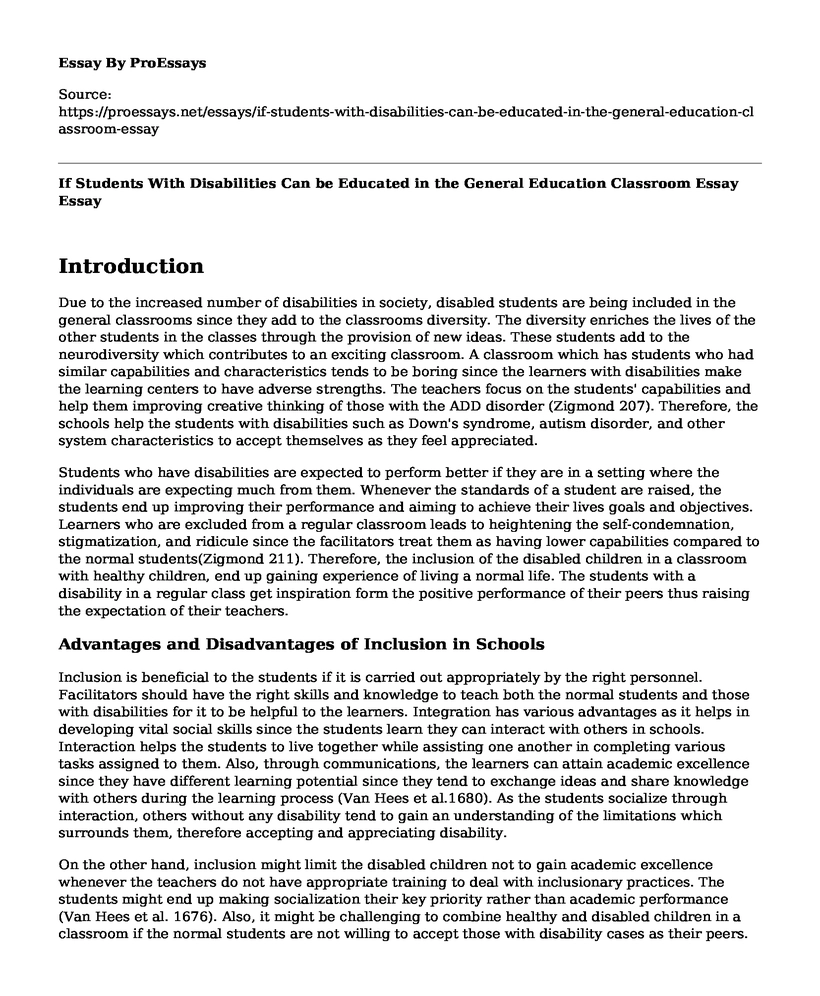Introduction
Due to the increased number of disabilities in society, disabled students are being included in the general classrooms since they add to the classrooms diversity. The diversity enriches the lives of the other students in the classes through the provision of new ideas. These students add to the neurodiversity which contributes to an exciting classroom. A classroom which has students who had similar capabilities and characteristics tends to be boring since the learners with disabilities make the learning centers to have adverse strengths. The teachers focus on the students' capabilities and help them improving creative thinking of those with the ADD disorder (Zigmond 207). Therefore, the schools help the students with disabilities such as Down's syndrome, autism disorder, and other system characteristics to accept themselves as they feel appreciated.
Students who have disabilities are expected to perform better if they are in a setting where the individuals are expecting much from them. Whenever the standards of a student are raised, the students end up improving their performance and aiming to achieve their lives goals and objectives. Learners who are excluded from a regular classroom leads to heightening the self-condemnation, stigmatization, and ridicule since the facilitators treat them as having lower capabilities compared to the normal students(Zigmond 211). Therefore, the inclusion of the disabled children in a classroom with healthy children, end up gaining experience of living a normal life. The students with a disability in a regular class get inspiration form the positive performance of their peers thus raising the expectation of their teachers.
Advantages and Disadvantages of Inclusion in Schools
Inclusion is beneficial to the students if it is carried out appropriately by the right personnel. Facilitators should have the right skills and knowledge to teach both the normal students and those with disabilities for it to be helpful to the learners. Integration has various advantages as it helps in developing vital social skills since the students learn they can interact with others in schools. Interaction helps the students to live together while assisting one another in completing various tasks assigned to them. Also, through communications, the learners can attain academic excellence since they have different learning potential since they tend to exchange ideas and share knowledge with others during the learning process (Van Hees et al.1680). As the students socialize through interaction, others without any disability tend to gain an understanding of the limitations which surrounds them, therefore accepting and appreciating disability.
On the other hand, inclusion might limit the disabled children not to gain academic excellence whenever the teachers do not have appropriate training to deal with inclusionary practices. The students might end up making socialization their key priority rather than academic performance (Van Hees et al. 1676). Also, it might be challenging to combine healthy and disabled children in a classroom if the normal students are not willing to accept those with disability cases as their peers.
Conclusion
The students who are suffering from various forms of disabilities are included in the general classrooms thus adding to the diversity of the classes. The facilitators in these classrooms tend to have acquired knowledge and skills of dealing with specific cases hence making the students to gain a lot from what they are teaching. Also, including the students in these classes has proved to become vital as they improve their performance when the teachers set targets for them. Inclusion in schools has helped other students to accept and appreciate cases of disabilities in classrooms. Therefore, disabled students feel cared for and recognized by their fellow students.
Works Cited
Van Hees et al. "Higher education experiences of students with autism spectrum disorder: Challenges, benefits, and support needs." Journal of autism and developmental disorders, vol.45, no. 6, 2015: 1673-1688. Retrieved from https://biblio.ugent.be/publication/7027122
Zigmond, Naomi. "Where should students with disabilities receive their education?" Enduring issues in special education: Personal perspectives (2015): 198-213. Retrieved from https://files.eric.ed.gov/fulltext/EJ785948.pdf
Cite this page
If Students With Disabilities Can be Educated in the General Education Classroom Essay. (2022, Dec 12). Retrieved from https://proessays.net/essays/if-students-with-disabilities-can-be-educated-in-the-general-education-classroom-essay
If you are the original author of this essay and no longer wish to have it published on the ProEssays website, please click below to request its removal:
- Healthcare Systems Management. Critical Thinking Example.
- Child Welfare Social Work Students Annotated Bibliography
- Paper Example on Delirium, Dementia, and Depression
- Breach of the Code of Conduct for Nurses on Person-Centered Care - Paper Example
- Essay Sample on Pathophysiology of Angina
- Nursing Knowledge Synthesis: From Natural, Social Sciences to Culturally Competent Care - Essay Sample
- Nurse Practitioners: Supporting Health Demands of the Population - Essay Sample







